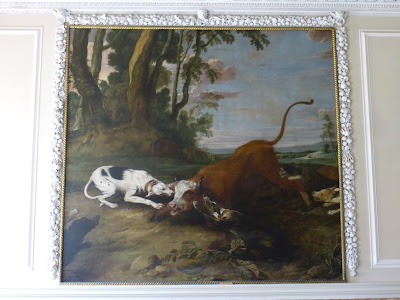After Chichester Cathedral, we walked and shopped a bit in Chichester, pretty even in the rain, and then drove on through the New Forest, on our way eventually to another home and garden, Kingston Lacy. New Forest was named by William the Conqueror. Evidently he found that the Saxons had already named everything, but he wanted a forest of his own and chose this one, giving it a new name: New Forest. We were actually looking for a specific tree, Knightswood, but never did find it. New Forest has been preserved, never logged, since William. I've seen my share of forests, and, frankly this one didn't seem much different from other seral forests. Oh well. We found a secluded (and forested) parking lot near the Badbury Rings, a mile from Kingston Lacy, and spent the rainy night there.
I was hoping to get more expeditious with the blog, since I am many days behind, but Kingston Lacy was so interesting in so many ways I have to give it two posts. Its guests over the years included the likes of Pitt, the Duke of Wellington, the Kaiser (1907) and more.
 |
The house, 1660s, remodeled extensively in the 19th; an Inigo Jones product,
although he died before it was completed |
 |
At the entrance are three more than life-size bronzes, the Lord
and Lady Bankes, and their Lord, Charles I; she's holding the
key because she held the keys to the Bankes family fortress,
Corfe Castle, which the Parliamentarians took at length but
only by stealth...they donned Royalist uniforms... hence the
expression, we were told, "turncoats" |
 |
Looking out at a side garden; it was a very blustery day, and the Trust had closed
all the gardens and forest paths |
 |
| Library |
 |
| Keys to Corfe Castle (which we'll visit shortly) |
 |
| A Guido Reni ceiling piece |
 |
| Another comfy room |
 |
| The dining room has an organ in it! |
 |
Annibale Caracci's Prometheus; one of three
Caraccis in the dining room |
 |
| Next room, a Velasquez portrait of a cardinal |
 |
This, a nice little copy of Las Meninas (note gold leaf label
above this and most of the other paintings); one of the later
Bankes was an ambassador to Spain and managed to pick up
a few paintings while there |
 |
And this, Rubens' very famous Portrait of Maria Serra
Pallavicino, a new sort of portrait style that heavily
influenced van Dyck, Reynolds, and Gainsborough |












.jpg)




































